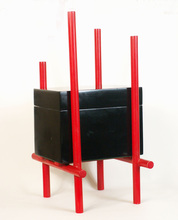Techniques

I try to achieve design that has clean uncluttered modern lines, reflecting my admiration for twentieth century art and design, whilst being aware that I am using techniques unchanged since the Renaissance.
The underlying structure of my boxes and mirrors is wood; that of my urns bowls and platters is papier mache.
Each piece is then coated with at least 10 layers of gesso (calcium carbonate and rabbit-skin size) When rubbed down, this gives a marble-like surface.
At the next stage I use one of the following techniques, or several in combination:
Glass: this is hand silvered using the verre eglomisee technique. Leaves of silver are floated onto the reverse of the glass, using gelatin and water. The gelatin is later removed by steaming, to render the surface clear and reflective.
The underlying structure of my boxes and mirrors is wood; that of my urns bowls and platters is papier mache.
Each piece is then coated with at least 10 layers of gesso (calcium carbonate and rabbit-skin size) When rubbed down, this gives a marble-like surface.
At the next stage I use one of the following techniques, or several in combination:
- Black lacquer – a classic oriental finish.
- Burnished Bole (gilder’s clay – comes in several colours, applied in thin layers)
- Silver, Gold or Noir AD (alloy of palladium and gold) Leaf. Silver can then be patinated.
- Paint – oil or acryllic – also used for trompe l’oeil lapis lazuli or malachite.
- Gesso, which can be raised, intaglio, sgraffito, or punched – to provide a wide variety of decorative effects. I also use twisted, gesso-soaked muslin, for a silver gilded rope effect.
Glass: this is hand silvered using the verre eglomisee technique. Leaves of silver are floated onto the reverse of the glass, using gelatin and water. The gelatin is later removed by steaming, to render the surface clear and reflective.
